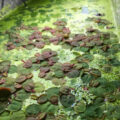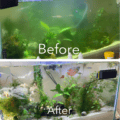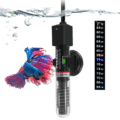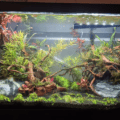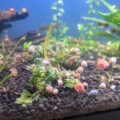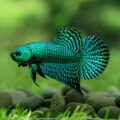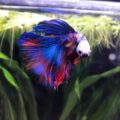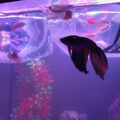Keeping a prehistoric fish species like the African Lungfish requires specific care practices to maintain its unique needs. This overview contains a comprehensive guide on achieving successful care, take a look!

African Lungfish: Prehistoric Tank Titan
Are you looking into prehistoric pet fish species that can become a centerpiece for your aquarium? Would you consider adding a prehistoric freshwater predator like Protopterus annectens to your aquarium?
Protopterus annectens, the African Lungfish also known as the Tana lungfish, is a large fish that grows about 3-4 ft long in maturity. It uses primitive paired lungs to breathe and has a unique estivation ability (more on this later).
In this African lungfish overview, you’ll learn all about this prehistoric air-breathing fish species, its hibernation habit, and how you can provide optimal care for it outside its natural habitat.
Author’s Note: Check out our post on The 13 Freshwater Aquarium Eels That Can be Kept as Pets for even more eels!
Natural Habitat & Unique Adaptations
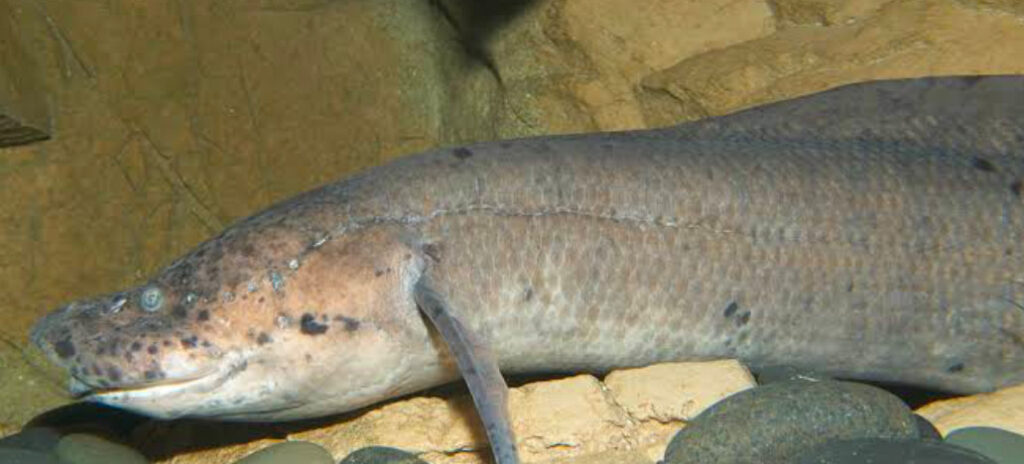
The African lungfish’s habitat spans several freshwater regions all over Africa, from the West to the Middle and the top half of the South. The Protopterus‘ environment has muddy waters since it’s mostly swamps, backwaters, and small rivers.
Unique Adaptations
Due to its natural habitat, the Tana lungfish developed unique abilities, starting with an estivation adaptation. Estivation is when a fish becomes dormant in certain seasons to conserve energy and survive harsh conditions.
This drought-surviving fish shields itself in a mucous cocoon burrow during the dry season to retain moisture, slow down its oxygen intake, and survive without food or water until the rainy season.
Let’s review some of this fish’s physical characteristics for easy identification.
Recognizing Features & Size
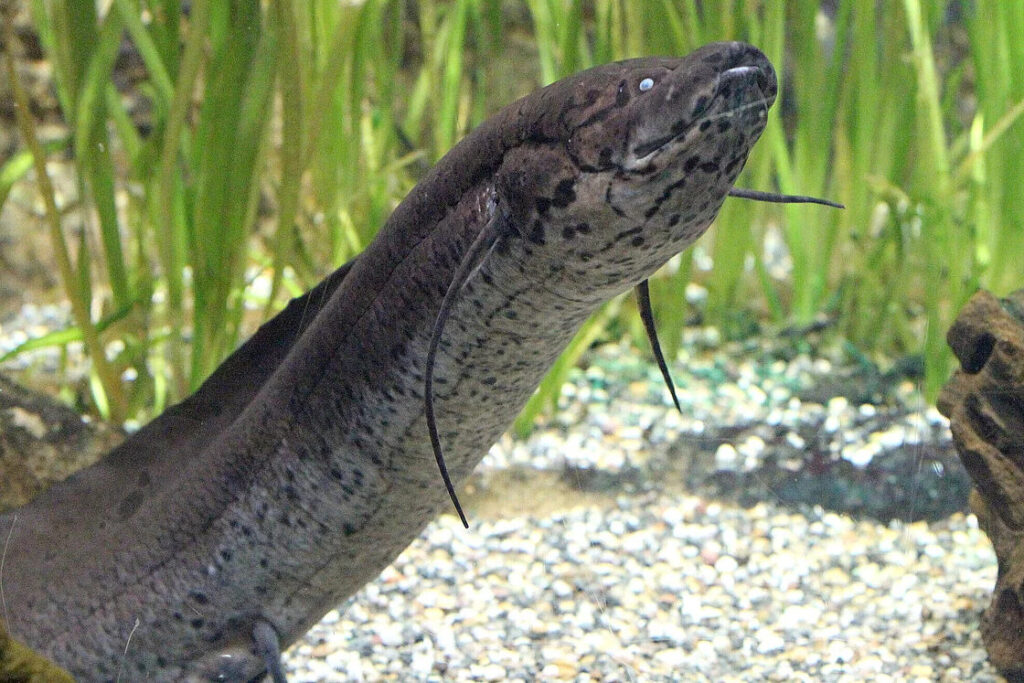
The African lungfish is a large freshwater fish with small pectoral fins on an elongated body that stretches between 3 and 4 feet.
Other distinctive Protopterus features include
- An aggressive jaw with a powerful bite on prey
- Partial blindness
- Lateral lines as sensory structures
- Sensory receptors extending from the snout to the tail
- Scales on the body
African lungfish have gills and lungs, which allow them to exhibit ancient fish traits like air breathing in low oxygen conditions and burrowing during drought.
You can also use the distinctive dual coloration when identifying African lungfish. Its upper body is often dark brown or olive with spots scattered around, while the underbelly is lighter and spotless.
Now, let’s discuss how to make this elongated carnivorous fish comfortable in an aquarium or pond.
Tank Requirements & Setup
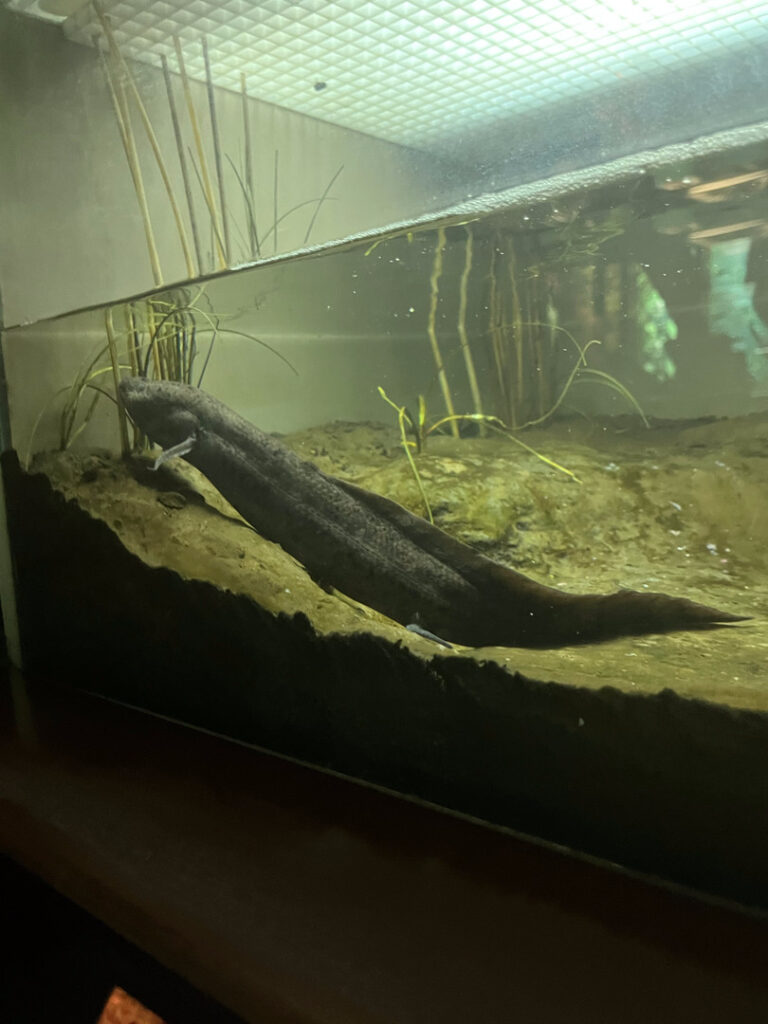
To build an ideal large fish aquarium, you’ll need a long tank or preferably a pond that holds at least 300 gallons of water. Because of its peculiarities, the best tank for Protopterus annectens would be shallow & long.
Other essentials for a proper African lungfish tank setup are as follows:
Substrate
Because of its burrowing habit, layer the bottom of your pet’s tank or pond with fine sand or mud substrate.
Decor
African lungfish love hiding, so you’ll need secure decor made of driftwood, smooth rocks, and live plants native to the African freshwater habitat for a realistic look.
Security & Oxygen
Besides hiding, this species also has a talent for escaping enclosures, so you’ll need a breathable heavy lid to keep them in check.
Also, ensure the enclosure stays aerated, even though African lungfish can survive long periods without oxygen.
Flow & Cleanliness

Penn-Plax Cascade All-in-One Aquarium Canister Filter
Found On Amazon
Maintain a low flow current but use a high-waste filtration system to keep water pristine. Speaking of water quality, let’s discuss the ideal conditions.
Water Conditions & Filtration
Set these African lungfish water parameters to mimic this species’ natural environmental conditions:
| Temperature | 75–86°F |
| Oxygen Level | low |
| pH Level | 6–8 |
After setting the ideal water conditions, you must maintain them with a good filtration system.
Filtration
Canister filter systems are the best for large fish filtration, especially the African lungfish, which releases a high bioload from messy eating. Now, let’s turn our attention to essential Protopterus care through dieting and feeding.
Author’s Note: Checkout the post on The 7 Best Aquarium Canister Filters Reviewed (2024) for an in-depth guide on choosing the right filter for your aquarium!
Diet & Feeding

This species survives on a carnivorous fish diet in the wild. So, use this African lungfish feeding guide to keep them nourished when in your care:
What to Feed Protopterus annectens
- Smaller fish,
- Mollusks,
- Shrimp
Feeding Guide
African lungfish are opportunistic feeders that wait for prey . It could eat smaller fish species, shrimps, or mollusks, which are its favorite food.
This mollusk-eating freshwater fish has a powerful, crushing bite, so be careful when feeding it. Use a feeding prong instead of your hands because they may bite you when startled.
Tank Mates & Temperament

Because of the African lungfish’s characteristics, it’s a territorial freshwater predator. It’s aggressive and feeds on other smaller aquatic species, so it’s best kept alone.
You can manage the Protopterus temperament by keeping it alone or pairing it with compatible species. Test your solitary predator African lungfish compatibility with potential tank mates based on their size, environmental needs, and temperament.
With caution, you can keep your pets with peaceful Reedfish, large Cichlids, and fast species that can escape predation.
Other specific solitary fish care practices to keep this pet in good health include:
- Avoiding stressful situations
- Providing hiding spots in the tank
- Keeping the water pristine.
Health & Lifespan

With proper care, this species can live for multiple decades
Although this species is hardy and can live for decades, only optimal African lungfish health care can maximize this potential.
Without specific ancient fish care practices to maintain its unique features like lungs and gills, your pet risks health problems.
Your pets face the risk of skin infections from poor water quality, and this illness can become complicated to the point of shortening the lifespan of Protopterus. So, scroll back up for details on proper water conditions and dieting to ensure optimal health, and you’ll give your pet a healthy, enclosed life where it rarely needs meds for stability.
Knowing how to manage large fish health properly also plays a role in your ability to breed them.
Breeding & Estivation Facts

Unlike most large fish species, there’s enough African lungfish breeding info to reproduce juveniles in a private space. So, buckle up because it’s about to get challenging, but it’s something you can handle.
Achieving this rare fish breeding in captivity requires skills and patience that are often reserved for experts. So, if you’re a beginner or intermediate-level aquarist, then this part isn’t for you, but if you’re a professional, keep reading.
Breeding Time
The first fact you should know about Protopterus reproduction is the appropriate season. This species breeds in the wet season before going into estivation.
Breeding Habits
The African lungfish builds a nest that looks like a pit in the mud or sandy substrate in preparation for mating.
The female Tana lungfish then lays her eggs, which are small with a diameter of 4mm, in captivity.
Egg Care
Afterward, the male African lungfish guards eggs until they hatch into larvae within two months. Once the larvae develop, caring for them becomes your responsibility.
larvae Care
African lungfish larvae first develop external gills for breathing, but as they grow older and larger, lungs take over.
They also develop fused tooth plates, unlike most fish juveniles. These tooth plates are useful for chewing small live food in the larval stage for good muscle and bone development.
Estivation

As your pets reach maturity, they begin showing unique African lungfish traits like burrowing in an estivation cocoon. This species forms a mucus around itself while under the muddy substrate and stays hidden until the rainy season.
While in estivation, this fish’s metabolism reduces, which allows it to survive the dry season. Once you master this rare fish breeding technique, you can reproduce as many African lungfish juveniles as you want.
Conclusion: Is the African Lungfish for You?
Now that you know this fish type is an extreme freshwater pet, let’s see if keeping African lungfish is for you.
Ask yourself the following questions:
- Can you manage a large tank setup?
- Are you equipped to handle the specific Protopterus pet care needs?
- Would you dedicate at least a decade to keeping this pet?
If you answered yes all through, then you’re ready to add this ancient aquarium fish to your collection.


